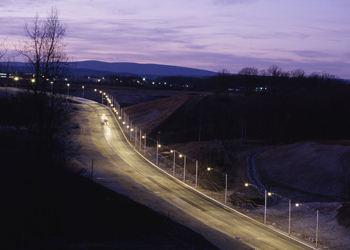Virginia Tech Transportation Institute Smart Road
 Background: Smart RoadThe Smart Road, located off of U.S Route 460 in Montgomery County, Virginia began construction in 1997 with the intention to alleviate traffic off of Route 460. The road was not completed to connect to 460, but presently, completed portion of road is 2.2 miles of the initially planned 5.7 miles in length. The Smart Road is exclusively used for car and pavement testing; and is not open to the public. There are 12 flexible pavement sections of the road, labeled as Sections A-L. While the Smart Road does not see large volumes of traffic, testing performed on the road, in addition to pavement aging, warrant an evaluation of the road’s condition and necessary maintenance. |
Project Introduction
In order to determine the present condition of the Smart Road
- Manual Distress Survey: Photos of the flexible pavement sections (dated 2008) were provided by Dr. Gerardo Flintsch of the Virginia Tech Transportation Institute.
- The photos for each section were carefully analyzed for signs of deterioration, such as cracking and weathering.
- Distress quantities and severities were determined and used in the ASTM D 6433-07 process to rate the pavement condition using the Pavement Condition Index (PCI) using the following distresses:
- Alligator (Fatigue) Cracking, Bleeding, Block Cracking, Bumps and Sags, Corrugation, Depression, Edge Cracking, Joint Reflection Cracking, Lane/Shoulder Drop Off, Longitudinal & Transverse Cracking, Patching & Utility Cut patching, Polished Aggregate, Potholes, Railroad Crossing, Rutting, Shoving, slippage Cracking, Swell, and Weathering/Raveling. The only distresses present in the Smart Road flexible sections were fatigue, longitudinal, and transverse cracking. ASTM D 6433-07 ranks distress severities as Low (L), Medium (M), and High (H), where distress of High severity have higher deduct values than those of a Low severity.
- The condition of the sections (described by PCI) were used to prioritize Maintenance and Rehabilitation (M&R) strategies.